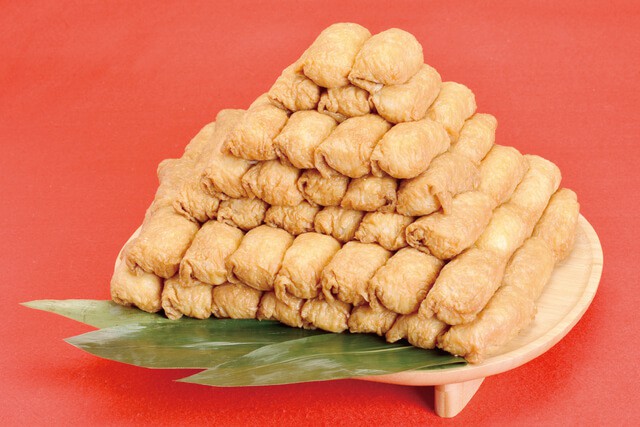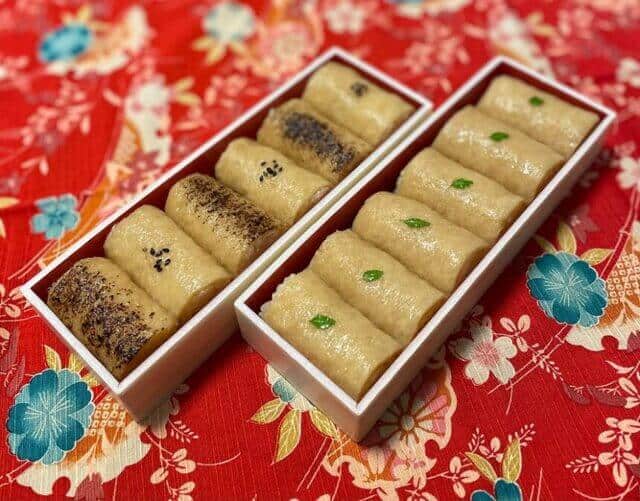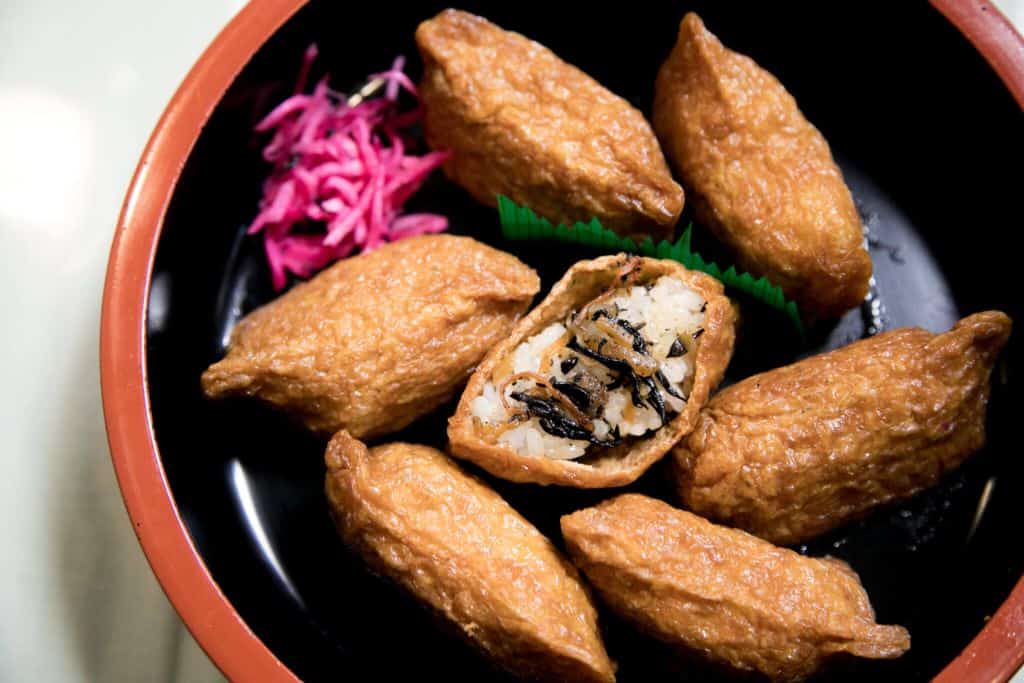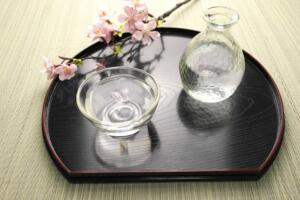If you are planning a trip to Kyoto or any other part of Japan, or even if you are thinking about having a sushi night at home, then you definitely need to try Inarizushi. The delightful flavors of this sushi variation are truly worth experiencing, whether you are in Japan or in the comfort of your own home.
Etymology of Inari Zushi

Inari sushi (いなり寿司) gets its name from Inari shrines because the priest of the Inari god likes fried tofu. Japanese used these shrines to worship the Shinto deity Inari, which is associated with foxes, rice, fertility, agriculture, and industry.
What is Inari zushi?

Inari zushi (いなり寿司) is a type of traditional Japanese sushi made by stuffing vinegared or sushi rice into sweet and spicy fried tofu. It is a kind of inro-zushi in which locals boiled the bag-shaped fried tofu sweetly or spicy together with the staffed sushi rice, or ingredients such as carrots and shiitake mushrooms. This is easy to make and eat and enjoy every day in Japan as a type of fast food. It is also called kitsune sushi (“fox” sushi) and konkon sushi. It is a popular and affordable dish across Japan. Locals can pick it up as a quick meal in convenience stores and supermarkets, while also being available at sushi and other Japanese restaurants as a side dish. Since inarizushi can easily be made at home and travels well, it’s a popular choice for bento (packed meals) to take to school, work, or a picnic.
Inarizushi History

Inarizushi was first introduced in Japan during the Edo period in the late 18th century. Its exact origins are unknown, though its namesake is a reference to Inari shrine in Kyoto. These shrines scattered across Japan are dedicated to a kami (deity) of fertility and business prosperity and are associated with foxes. Japanese folklore claims that foxes love aburaage, and thus aburaage was a common offering to leave at shrine grounds. The messengers to these deities are foxes and according to folklore, their favorite food is inari.
According to the “Yamashiro Kokudo Fudoki Lost literary work Inarishajo” in the Nara period, “Hita no Irogu, the ancestor of Mr. Hata, devoted himself to his richness and made rice cakes. When he tried to shoot a bow, the rice cake turned into a white bird and flew away to the top of the mountain, where rice grew. The mountain was originally called Inariyama, and the origin of the mountain changed to “Inao” and “Inari”.
There are various theories, but Inari Shrine is the object of the deep faith of the common people, and many people loved Inari sushi and eat this until now.
Inarizushi Recipe

Inarizushi Ingredients
| Ingredients of Inarizushi for 16 people | |
| Aburaage | 160g (8 pieces) |
| Rice | 500g |
| White roasted sesame | 14g |
| Mustard | 10g |
| Dashi soup | 200g |
| Sugar | 73g |
| Soy sauce | 42g |
| Rice vinegar | 28g |
| Salt | 4g |
How to make Inarizushi?
Prepare a square aburaage and cut it horizontally or diagonally as you like (this time, cut it diagonally to make triangular inari sushi). For the cut fried tofu, put your thumb through the cut and gently open it to the corner so that the fried tofu does not have a hole.
After arranging the fried tofu in a pan, lightly mix dashi soup, sugar, and soy sauce in a separate container and then pour into the pan. Put the pot on medium heat, and when it boils, cover it with a lid and reduce the heat to low. After cooking for 10 to 12 minutes, the aburaage will absorb most of the broth, leaving a slight broth on the bottom of the pot.
First, prepare vinegared rice. Melt the sushi vinegar, sugar, and salt well and mix it. Then, sprinkle it on freshly cooked rice, and mix it. After mixing the whole, spread the vinegared rice, cool it with an uchiwa, and mix the sesame seeds.
Lightly squeeze the broth in the aburaage. Once you have the vinegared rice and the aburaage, you can start the stuffing. After that, take the sushi rice in your hand, put the sushi rice that you rolled up earlier, and lightly press it with your thumb so that the vinegared rice spreads to the back.
As a side dish, the taste of wasabi pickled in soy sauce, new ginger pickled in sweet and sour sauce, and easily kneaded mustard are also delicious.
The key point when stuffing is to lightly roll the vinegared rice into the amount to be stuffed one by one first. And to proceed with the work while gradually adding the broth from the cooked aburaage to your hands.
What are the various types of inari zushi?

Shirasu no Ume Inari
It is a dish that goes well with the sourness of plums and the umami of shirasu. It is refreshing so locals recommended it even on hot days or when you’re tired.
Sukeroku Sushi
A set consisting of thick futomaki sushi rolls and inari sushi is “Sukeroku Sushi”. You will find this in supermarkets in Japan, train stations that sell bento, and at sushi restaurants.
Nozawana Inari zushi
This is an inarizushi that you can enjoy by chopping pickles and adding them to vinegared rice. Pickled Nozawana has good color and texture. By intentionally finishing the vinegared rice with a light taste, it will have just the right taste when combined with the pickles of Nozawana and the skin of Inari.
Matsumaezuke
On the other hand, locals filled the Matsumaezuke inari sushi with the flavors of kazunoko, dried squid, and kelp that goes very well with the sweet and juicy Inari sushi. The texture of Matsumaezuke and white sesame are accented and delicious.
Ginger Inarizushi
The sweet and sour pickled ginger goes great with vinegared rice and the sweet and juicy Inari sushi. The texture of finely chopped new ginger is fun, and locals added the flavor of white sesame to make it delicious.
What’s the Difference Between Inari Sushi in Kanto and Kansai?

Food culture and various traditional Japanese dishes evolved quite differently in the Kanto and Kansai regions. Inarizushi is no exception. In Kanto, aburaage pouches are rectangular shaped, reminiscent of a rice bag. In contrast, aburaage pouches are triangle-shaped in Kansai. The shape is like fox ears – remember that according to Japanese myth, foxes love aburaage. Another difference between the two types of regional inari sushi lies in the rice filling. While Kanto-style inari sushi usually contains only vinegared rice, Kansai inarizushi often has other ingredients mixed into the rice. This is why locals in Kansai inarizushi called this Gomoku inari, its Japanese name alluding to the fact the roll contains five ingredients total – three in addition to the rice and aburaage.
Recommended Inari zushi Restaurants
Genmai Kyoto Gihee (玄米 京都ぎへえ)

Kyoto Gihee is a rice restaurant in Kyoto that is always very popular and many people lined up here. The rice used is brown rice called “Kin no Ibuki”. The shop said that they blended 8 kinds of domestic millet with this. The fried food is a Kyoto-style delicate one. They cook it with plenty of soup stock that is a blend of 5 types of sardine, mackerel, mackerel, and bonito. There are 6 types of flavors: sesame, yuzu, wasabi, ojako, shibazuke, and beef shigure. This restaurant also offers hime inari, a cute princess-sized inari sushi that women can eat in one bite.
Ginza Uokatsu (糧亭 銀座魚勝)

“Ginza Uokatsu” is a famous inari sushi restaurant known to those in Ginza, Tokyo. This is an obanzai eat-in and take-out shop that was reopened in December 2019. Inari sushi that the soup stock spreads in your mouth the moment you eat a bite. There are two flavors, “Wasabi conger eel and Fragrant fried rice. Wasabi conger eel contains plenty of conger eel, and has a soft texture and a delicious accent of wasabi. It is recommended that you attach a little mustard to the standard Gomoku Inari.
Kawamuraya (河村屋)

“Kawamuraya” inari sushi is heavy and has a satisfying taste. It is a hot topic that has been featured in different media. This store is a take-out specialty store that sells inari sushi, dried gourd rolls, pork soup, etc. It is a small shop loved by locals. The vinegared rice with seaweed goes perfectly with the soft-boiled egg that spills out. Inari sushi with a series of repeaters that makes you addicted once you eat it.
Izuhei (泉平 馬車道本店)

Their style is to use a piece of fried tofu as it is, stuff it with vinegared rice, and then cut it in half to make it easier to eat. The seasoning that is neither too sweet nor too strong is truly exquisite. You can taste the original inari sushi that has been popular in Japan for a long time.
Convenience Stores that sells Inari zushi
7-Eleven (セブン-イレブン)
At 7-Eleven, “Inari Sushi Umeshiso” is on sale. It is sushi with a characteristic crispy plum texture. Along with the sweetness of fried tofu, the refreshing taste of plums comes out on the whole surface. They seasoned the rice itself with plums, so it is different from dried plum rice balls. In addition, 7-Eleven also sells “Gourmet Inari” (135 yen). Ingredients such as carrots, bamboo shoots, lotus roots, burdock roots, and Kanpyo are used.
Lawson (ローソン)
At Lawson, “Inari-san Gome” is on sale. In the case of onigiri-style inari sushi, there are many things that the fried tofu does not cover the whole, but in this Lawson’s” Inari-san Gome “, the fried tofu covers the whole. The seasoning of the fried tofu is effective. The sweetness is modest. In that sense, the “onigiri” style is stronger while maintaining the “inari sushi” style.
FamilyMart (ファミリーマート)
“Yuzu Inari Sushi” is on sale at FamilyMart. It is inari sushi that uses yuzu peel to add aroma to vinegared rice. Shiitake mushrooms and Kanpyo are its ingredients. It is refreshing sushi with a faint scent of yuzu. The sesame seeds in the vinegared rice give it a moderate accent, and the scent is more pronounced.
Takeaway

There’s a whole world of sushi out there and saba sushi is one of the simplest, yet most delicious types available. Borne from traditional Japanese methods, the recipe has become a popular yet accessible meal for those who want to experience authentic Japanese cuisine either in the country itself or at home. It goes great on its own or with other types of sushi, like bekko sushi or edomae sushi.
















Comments